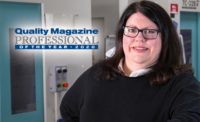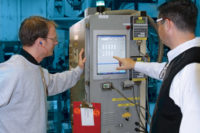If you have a problem, you want to have Katherine Cox around. The senior quality assurance director of medical device startup Procyrion is known for her calm problem solving manner, collaborative attitude and straightforward approach to quality. She’s worked on products for space as well as the human body. And she’s been hands-on in her approach to quality throughout.
After an audit of a critical supplier found quality system issues, Cox spent several days with the supplier until the issues were resolved. Former colleague Natasha Bond explains, “She saw risk to our business and decided that the best thing was to personally help the supplier resolve the issue.”
“The way she handled that is a great summary of the skill set she brought into the organization,” says Charles Tribie, another former colleague at IDEV Technologies.
From outer space to internal organs
the range of products that Katherine Cox has worked on in her career:
- Space Shuttle Main Engine Controller (Honeywell Aerospace)
- Superconducting Super Collider Magnet (General Dynamics)
- Pacemakers and Defibrillators, Leads and Accessories (Sulzer Intermedics (Acquired by Guidant Medical 1999))
- Vascular and Biliary Stents (IDEV Technologies (acquired by Abbott Laboratories 2013))
- Aortix System for circulatory support (Procyrion)
She’s worked at large and established aerospace companies as well as small medical device startups and done well at all of them. Cox did not know she was nominated by her Procyrion colleagues for the Quality Professional of the Year award until she won. She’s open and straightforward, colleagues say, and through her guidance, she’s helped the company implement a new quality system—despite being a quality team of one.
Her problem solving skills, team mindset and dedication to quality have earned her our 2017 Quality Professional of the Year award.
From the Start
Picture a ten-year-old helping to change the carburetor on her grandpa’s Buick and you’ll get an idea of her mechanically inclined childhood. Her dad was a jack of all trades, and she loved science and engineering and initially thought she might study medicine. This changed in college. “Invertebrates were not my bailiwick as I discovered in my second zoology course,” Cox says, so she switched to engineering and graduated with a mechanical engineering degree and later with a master’s degree in engineering management.
She started her career at Honeywell Aerospace’s Space System Division as a component application engineer supporting various navigation and guidance programs, and as a quality engineer on the Space Shuttle Main Engine Controller Program. From there, she took a quality manager position in the space systems division of General Dynamics developing and manufacturing magnets for the Super Conducting Super Collider program. When the collider program was terminated after two years, she moved to the medical device industry at Sulzer Intermedics as a quality manager supporting the development and manufacture of leads and ancillary devices for pacemakers and defibrillators.
“I was able to convince them that a manned space flight quality system was no different than that required for human implants,” she says. When the company was acquired, she took time off to raise her two children, and then continued to work in the medical device industry when she joined IDEV Technologies, and again in her current position at Procyrion Inc.
Solving Problems
Natasha Bond met Cox when they were both working at IDEV. “Her willingness to be part of the solution is what makes her stand out,” says Bond. “The default as a quality engineer is to be more of a check-box, stage gate; she’s much more proactive and involved than that.”
“When we were directly working together, the FDA changed their stance on industry’s use of colorants in medical devices. We, along with other companies in the medical industry, had a product on the market that was suddenly not compliant with the new FDA guidance,” Bond says. Changing the colorant and pigment was an onerous process that involved working with an extruder, assessing the pigment change on the function of the finished device and the potential effect of the change on the product sterilization process. “Katherine was very, very pragmatic. This is what we must do today to show the FDA we are doing everything we can to mitigate as much of the patient risk as possible with the current product while we work to change the pigment on future product. We were able to perform a risk-based chemical analysis on the currently marketed product proving that the colorant wasn’t actually causing harm. We were able to keep the product on the market, a huge thing for a small company, during the 10-month process to obtain approval for product manufactured with new pigments.”
Ronnie Earles, director of product development at Procyrion Inc., also worked with her at IDEV. “I’ve been doing medical devices for a while. I talk to a lot of people, inexperienced people, and they think quality is this thing that they will tack on at the end, something they can buy, quality in a box, which is not the case at all.”
Cox combated this myth and helped the team adopt a quality system that made sense for them and was right sized for the stage of the company. Medical devices require the utmost attention to quality, and startup companies require the same controls and documentation as multibillion dollar medical device companies when developing design requirements, conducting characterization and product testing, and creating a design history file and device master record.
Charles Tribie also worked with her at IDEV in his role as senior vice president of operations. Despite working in operations and quality, the two of them got along well. “It can be a contentious relationship between operations and quality. Katherine kept that relationship very cordial. We had a good working relationship. She wasn’t confrontational, allowed the company to work as a team, with one goal in mind. Obviously, we all want to put a product out with the highest quality.”
Right the First Time
After IDEV was acquired, Cox began doing medical device consulting for companies such as Procyrion. She started working for the company full-time in December 2015. “Katherine is great to work with,” Earles says. “I think one of the smartest things they’ve done is hire Katherine.”
“Katherine is a unique quality professional,” says Chris Durst, PhD, senior director of product development at Procyrion Inc. “She’s kind of different from the other folks I’ve worked with in the past. She is rigid and disciplined and makes sure we are following the appropriate standards when she needs to be, and totally flexible and willing to make things work, because she realizes we are a startup.”
Developing the quality system took a lot of time and energy. “It was a lot of work, and Katherine was patient with us when we tried to work within a quality system in the beginning,” Durst says. “Certainly, there was a perception that a quality system was an impediment and not a tool we could use to our benefit.”
“For startups, cash is king. Our product is a disposable medical device and if we use it in an animal study and we don’t have rigorous protocol for documenting the test article configuration, test setup and test results, that design history file element is now useless. There’s a lot of cost that goes into prototypes and it’s crucial to optimize the number of studies that we do to obtain the biggest bang for the buck. By implementing a risk based product development process, we’ve reduced development scrap and waste while ensuring the user, patient and regulatory needs are met.”
Cox helped the group pace themselves, introducing quality system elements as needed rather than all at once. This helped improve quality and reduce waste by doing things right the first time, one of her quality philosophies.
Benjamin A. Hertzog, president and CEO of Procyrion, says having her on staff has been invaluable. “From the CEO’s perspective, I don’t have to worry about it getting done with her. She knows what’s got to get done, does it or helps the rest of the team. Katherine works hard yet she’s one of the most well-liked members of the team,” Hertzog says. “Filling out quality documents is not what my team wants to be doing, they want to be in the lab innovating,” but she makes things happen, he says.
The company went through a lot of work to get ready for their first in-human studies, one of the big milestones of the past year, Hertzog says, and they had to make sure the quality system was up to par. “The thing I appreciate the most is that she tells us what needs to be done, and educates team members how to institutionalize the quality system. It’s not the binders; it’s the behaviors that are required. She’s very good at educating us, we value her ability to educate and train and institutionalize these behaviors.”
Startup Quality
Implementing the quality system was a process. “When I started with Procyrion, I asked, ‘Do you have a quality system?’” Cox says. “Six white binders were retrieved from an office shelf and put on the table followed by ‘This is what we bought, but we don’t know how to use it.’”
The quality system had been purchased from a consulting group six months prior. The engineers had never worked within a quality system before so they didn’t know what to do with it, and there was no one on board with experience working within a system. After scrapping the purchased system, and starting from the beginning, she helped them to see that the quality system is in reality a beneficial development and business tool.
“A quality system is basically a good risk-based business model,” Cox says. “In the same way a company utilizes a detailed business plan to reduce business risk and achieve success, a start-up utilizes a detailed quality system to ensure the developed product meets customer (user, regulatory, patient, market) and business needs. A right-sized QMS ensures product risks as well as business risks are addressed for success of the project and the business.”
And she’s seen changing attitudes toward quality since her career began.
“Quality was often considered the traffic cop, or a roadblock. In my opinion, this attitude stemmed from the use of the term ‘quality control.’ I’m glad to see the change to ‘quality assurance,’ and that the quality team, even if it is a team of one, is seen as a partner helping to assure product quality. More and more the value that quality professionals provide is being recognized,” Cox says. “The quality system isn’t just the quality director or quality manager; quality has to be the culture of the company. It’s imperative that your engineers, your operators, etc. wear a quality hat in addition to their other responsibilities that they understand their role within the quality system, and they understand their individual impact on product quality. Only then can product quality be assured, because quality has been built into the product from concept, through design and manufacture, and to delivery to the customer.”
For those looking to advance their career, she suggests getting as much experience as possible in different facets of the industry. For quality professionals, she says obtaining experience in supplier auditing, specification writing, documentation control, manufacturing, risk management, and design control is instrumental. Broad experience is especially important to be a valued team resource.
Her range of experience has helped in her current position, and she says it’s been rewarding work. “That’s what I love to do and am passionate about,” Cox says. “I find it very interesting and challenging, and no two days or development projects are alike. It’s really rewarding to be part of a small company and have a great impact on the team by helping them navigate the quality systems and regulations, as well as have input into the product development and manufacturing process. Seeing a product your team has developed result in a quality of life benefit to another person is extremely satisfying and rewarding.”
Click here to take a look at past Quality Professionals of the Year.









